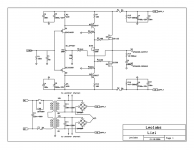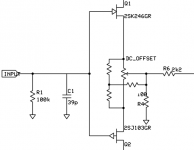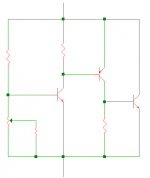Only one weak point due to non-strictly-matched components😱utput offset drift.First turn-on is around -100mV,then settle to +30mV after usage.
Hi Leolabs! Nice mini design.
Do you have spice models for latheral mosfets? (for circuitmaker), have you simulated it before you made it and what are the differences in spice and real operation?
how does it sounds?
Do you have spice models for latheral mosfets? (for circuitmaker), have you simulated it before you made it and what are the differences in spice and real operation?
how does it sounds?
Yes, R8 and R12 are useless in this case, but ther`s no need for thermal compensation! These are lateral mosfets(2SK134/J50).
cheers!
cheers!
bogdan_borko said:.........there's no need for thermal compensation! These are lateral mosfets(2SK134/J50).
cheers!
Who said anything about thermal compensation?🙂
bogdan_borko said:Yes, R8 and R12 are useless in this case.....
cheers!
On the contrary, they are useless in every case.
mikeks said:
On the contrary, they are useless in every case.
Nope, lowering vas z-out using these is beneficial... Not only to my ears. 😉
Also, they expand OL-bandwidth, and reduce openloop distortion ~the same amount they reduce openloop gain.
Also, you don't want the capacitance of the mosfet gates to be the only load to the vas, unless you prefer to listen to integrators. (The PIM story)
Mike
MikeB said:
Nope, lowering vas z-out using these is beneficial... Not only to my ears. 😉
Also, they expand OL-bandwidth, and reduce openloop distortion ~the same amount they reduce openloop gain.
Also, you don't want the capacitance of the mosfet gates to be the only load to the vas, unless you prefer to listen to integrators. (The PIM story)
Mike
Wrong; in all respects.
They reduce foward-path gain, which means they reduce loop-gain, which means they increase distortion.
You do NOT reduce ''PIM'' or other dubious distortion mechanisms by reducing loop-gain. Period.
They do NOT ameliorate ability to drive MOSFET capacitance, as this remains unchanged regardless.
Indeed, they merely siphon off current that would otherwise be used to drive said capacitance.
A complete nonsense.

mikeks said:
They reduce foward-path gain, which means they reduce loop-gain, which means they increase distortion.
Not complete nonsense... Could you please read my whole post ?
Yes, they reduce loop-gain, but as they linearize the vas by "protecting" it against the terrible dynamic load from the outputstage the overall distortion level reduces at high freqs.
If you insist in optimizing an amp for 1khz, skip these resistors...
I should know better to not have started again this ugly discussion.
Go, heat up your soldering iron and compare by ear the difference between rloaded vas and pure capacitive loaded vas.
And yes, books say that flat OL-bandwidth is nonsense, again try and LISTEN the difference !
Mike
so what`s this circuit you posted for?Replace R10 with this:
I also tought that R8 and R12 are for lowering open loop gain of the VAS stage...
who`s right here?
P.S. (I have to notice,sorry) :Mikeks always says something in contrery...
MikeB said:Yes, they reduce loop-gain, but as they linearize the vas by "protecting" it against the terrible dynamic load from the outputstage the overall distortion level reduces at high freqs.
You cannot ''linearize the vas'' by increasing the loading at its output.
This neccesarily reduces its local gain, which must increase its non-linearity, and in no way ''protects'' it from ''the terrible dynamic load from the outputstage'', for it merely worsens it.
This is because these shunt resistors are in parallel with the input impedance of the output stage, and, therefore, can only reduce the effective impedance ''seen'' by the second stage.
bogdan_borko said:
so what`s this circuit you posted for?
I also tought that R8 and R12 are for lowering open loop gain of the VAS stage...
who`s right here?
P.S. (I have to notice,sorry) :Mikeks always says something in contrery...
Read this carefully.
Simply study an amp in sims with the feedback loop opened... (not at 1khz !) Do not forget AC-sweeps to observe bandwidth and phaseshifts.
Yes, these resistors do not linearize the vas-devices themself, but... Why do i discuss ? I am wrong anyway... (tired of that)
Mike
Yes, these resistors do not linearize the vas-devices themself, but... Why do i discuss ? I am wrong anyway... (tired of that)
Mike
MikeB said:Simply study an amp in sims with the feedback loop opened...
Why ''with the feedback loop opened''?
mikeks said:Why ''with the feedback loop opened''?
Because of openloop distortion. Openloop distortion will be reduced by feedback, but as additional gift you get "upfolded" high order harmonics. (The distorted distortions thing) Because of this, openloop distortions need to be kept reasonably low and openloop bandwidth high to have feedback reserves to reduce these new high order distortions which have much higher frequency than the ones to be compensated.
BTW, this was the only weakness of NFB i was able to prove with virtual devices in sims.
Mike
- Status
- Not open for further replies.
- Home
- Amplifiers
- Solid State
- latest version of Lizi


